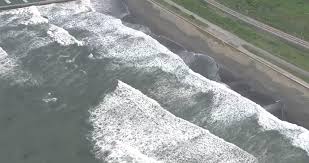A massive undersea earthquake has rattled the Pacific, triggering tsunami waves that have already impacted coastal areas of Japan and Russia. The event, which occurred late on July 29, 2025, has set off widespread tsunami alerts, reaching as far as California, Hawaii, and Alaska, urging residents to stay clear of beaches and coastal zones.
Let’s break down what happened, the science behind tsunamis, the extent of the damage, and what people across the Pacific Rim need to know right now.

Tsunami Hits Japan and Russia
What Exactly Happened: Earthquake Details
On Tuesday, July 29, 2025, at approximately 11:12 PM local time, a powerful magnitude 8.8 earthquake struck off the east coast of Russia’s Kamchatka Peninsula, close to the Kuril Islands. This region lies on the Pacific Ring of Fire one of the most seismically active zones on Earth.
Earthquake Parameters:
- Magnitude: 8.8 (moment magnitude scale)
- Epicenter: Near Kamchatka Peninsula, Russia
- Depth: Estimated at 22 kilometers (13.6 miles)
- Tectonic setting: Subduction zone where the Pacific Plate dives beneath the Okhotsk Plate
The massive tectonic shift underwater triggered a tsunami that began radiating across the Pacific Basin within minutes. These tsunami waves were observed to grow in height as they approached coastal zones, especially around Russia’s Far East and northern Japan.
Tsunami Impact on Russia
The Kuril Islands and parts of eastern Russia, including Severo Kurilsk, experienced the brunt of the initial waves. Water levels surged up to 3 meters (about 10 feet) in some locations.
Reported Effects:
- Mass evacuations from coastal towns
- Power and communication outages
- Minor infrastructural damages in low lying coastal communities
- No confirmed fatalities as of this writing, but multiple injuries reported
Russian emergency services promptly issued tsunami warnings, advising residents to move inland and seek higher ground. Several towns are currently operating under emergency status.
Tsunami Reaches Northern Japan
In Japan, the tsunami affected parts of Hokkaido and the Tohoku region, already familiar with tsunami disasters, especially after the tragic 2011 Tohoku earthquake and tsunami.
Key Impacts:
- Wave heights up to 60 centimeters (2 feet) recorded along the northern coast
- Over 2 million people evacuated as a precaution
- Train services and flights suspended
- No casualties reported so far
- Japan’s nuclear plants reported no damage; safety systems activated immediately
The Japan Meteorological Agency (JMA) issued emergency warnings, which were lifted a few hours later once the tsunami waves subsided.
PacificWide Tsunami Warnings: California, Alaska & Hawaii on Alert
Following the seismic activity, the Pacific Tsunami Warning Center (PTWC) issued tsunami watches and advisories across the Pacific Ocean.
USA Impacts:
California:
- Tsunami advisory issued for Northern California
- Crescent City, Monterey, and San Francisco identified as high-risk spots
- Waves expected to reach 2–4 feet
- Residents advised to stay off beaches, jetties, and harbor areas
Hawaii:
- Emergency alerts sounded statewide
- Expected wave heights of 1–3 feet
- Residents asked to avoid low-lying coastal areas
- No evacuation ordered, but tsunami surge could last several hours
Alaska:
- Coastal communities on tsunami advisory
- Localized waves may exceed 3 feet in Aleutian Islands
- Harbors and marinas closed as a precaution
As per NOAA and USGS, no major inundation is expected in the U.S., but dangerous currents could persist for 24–36 hours, especially in coastal harbors and channels.
What is a Tsunami? Understanding the Basics
A tsunami is a series of long ocean waves caused by sudden, violent movements of the Earth’s crust typically from undersea earthquakes. Unlike normal waves, tsunamis can travel across entire oceans at jet speeds of 500–800 km/h (310–500 mph).
Causes of Tsunamis:
- Undersea earthquakes (most common)
- Volcanic eruptions
- Landslides
- Meteorite impacts
When these displacements occur beneath the ocean, vast volumes of water are suddenly thrust upward, forming waves that spread out from the epicenter. These waves grow taller as they approach shore, creating massive surges capable of destroying entire coastlines.
Notable Past Tsunamis Around the World
2011 Japan Tsunami
- Magnitude: 9.0 earthquake off Sendai
- Over 18,000 deaths
- Fukushima nuclear meltdown
- ~$235 billion in damages (world’s costliest natural disaster)
2004 Indian Ocean Tsunami
- Magnitude: 9.1 earthquake near Sumatra
- Tsunami struck Indonesia, India, Sri Lanka, Thailand
- Over 230,000 deaths across 14 countries
1952 Severo Kurilsk Tsunami (Russia)
- Magnitude: 9.0 quake
- Entire town destroyed
- Over 2,300 deaths
1964 Alaska Tsunami
- Magnitude: 9.2 (2nd largest ever recorded)
- Waves hit Alaska, Oregon, California
- Over 130 deaths and widespread destruction
What To Do During a Tsunami Warning
Whether you’re in Japan, Russia, or California, knowing how to respond can save lives.
Do’s:
- Evacuate immediately if you feel a strong quake near the coast
- Follow official alerts on radio, TV, or emergency text
- Move to high ground or inland 100 feet above sea level or 1 mile away
- Stay away until authorities give the all clear
Don’ts:
- Don’t go to the beach to watch the waves
- Don’t return too early, multiple waves can come hours apart
- Don’t rely on just your phone keep a radio or local alert device ready
Final Word: Nature’s Reminder to Stay Prepared
The July 2025 tsunami is a stark reminder that the Pacific Ring of Fire remains one of the world’s most volatile seismic zones. While Japan and Russia managed quick evacuations, the threat of ocean borne disasters looms large especially for Pacific countries like the United States.
Authorities acted fast, and casualties have been minimal but the key takeaway remains: Preparedness, awareness, and quick response save lives.
Stay alert. Stay safe. Respect nature’s power.
Tsunami Hits Japan and Russia : Frequently Asked Questions (FAQs)
Q. What caused the tsunami on July 29, 2025?
The tsunami was triggered by a massive 8.8 magnitude undersea earthquake near Russia’s Kamchatka Peninsula, close to the Kuril Islands. This region sits along the Pacific Ring of Fire, where tectonic activity is extremely high. The abrupt movement of tectonic plates displaced a huge volume of water, generating powerful tsunami waves.
Q. Which areas were affected the most by the tsunami?
The most impacted areas were:
- Severo Kurilsk and eastern coastal towns in Russia
- Northern Japan, especially Hokkaido and the Tohoku region
- Parts of California, Alaska, and Hawaii were placed under tsunami advisory due to expected wave surges
Q. Was there any damage reported in the United States?
In the U.S., no major structural damage was reported. However:
- Crescent City (CA) experienced minor flooding risks
- Strong ocean currents and wave surges of 2–4 feet were seen along the California coast
- Warnings were issued for harbor and beach safety
Authorities advised citizens to stay away from the coastlines, piers, and beaches for 24–36 hours.
Q. How high were the tsunami waves in Russia and Japan?
- In Russia’s Kuril Islands, wave heights reached up to 3 meters (10 feet)
- In Japan, waves were recorded up to 60 centimeters (2 feet)
Despite the difference in wave size, emergency protocols were activated immediately in both countries to minimize risks.
Q. Was this tsunami as severe as the 2011 Japan tsunami?
No. While the July 2025 tsunami was serious, it was not as devastating as the 2011 Tohoku tsunami, which was caused by a 9.0 magnitude quake and led to over 18,000 deaths and a nuclear disaster. In the current event:
- Casualties have been minimal
- Early warning systems and preparedness played a crucial role in damage mitigation
Q. What is the difference between a tsunami warning, watch, and advisory?
- Tsunami Warning: Tsunami is imminent or already occurring; move to higher ground immediately.
- Tsunami Watch: Potential tsunami due to a distant earthquake; stay alert and follow official updates.
- Tsunami Advisory: Tsunami waves expected; not large enough to cause flooding but can produce strong currents.
In this case, the U.S. was placed under advisory, not a full warning.
Q. How fast do tsunami waves travel?
Tsunami waves can move at speeds of 500 to 800 km/h (310 to 500 mph) in deep water comparable to a jetliner. As they approach land, they slow down but gain height, sometimes turning into devastating walls of water.
Q. Are there still risks after the first wave hits?
Yes. Tsunamis are not a single wave, multiple waves, known as a “wave train,” can strike over several hours. In some cases, the second or third wave may be larger than the first. That’s why officials urge people not to return to coastal areas until the all clear is given.
Q. How can people in coastal areas prepare for tsunamis?
- Know your evacuation routes and safe zones
- Sign up for local emergency alerts
- Keep an emergency kit with essentials
- If you feel strong shaking near the coast, evacuate immediately, don’t wait for a siren or alert
- Practice family emergency drills
Q. Is climate change responsible for more frequent tsunamis?
While climate change doesn’t directly cause tsunamis, it can increase vulnerability. Rising sea levels can make even smaller tsunami waves more destructive by pushing water further inland. Also, warming oceans may influence undersea landslides that could trigger tsunamis.
Q. What are the safest places during a tsunami?
- 100 feet above sea level or at least 1 mile inland
- Designated evacuation zones marked by local authorities
- Sturdy, multi story buildings can offer temporary shelter in urban areas (last resort)
For the Latest Trending News Please Follow Popnewsblend.com

Hi, I’m Prashant Jain — a curious soul, storyteller, and content creator at heart.I’ve always been drawn to the world of entertainment, travel, sports, health & lifestyle — not just as a writer, but as someone who genuinely lives these experiences. Whether I’m binge-watching the latest OTT series, exploring offbeat spiritual destinations in India, or diving deep into wellness routines and cricket match insights, I love sharing what I discover with like-minded readers.
PopNewsBlend is my way of blending personal journeys with meaningful stories — ones that inform, inspire, and keep you ahead of the curve. Everything I write comes from real observations, hands-on experiences, and a deep passion for understanding the world around us.
Discover more from Popnewsblend
Subscribe to get the latest posts sent to your email.







